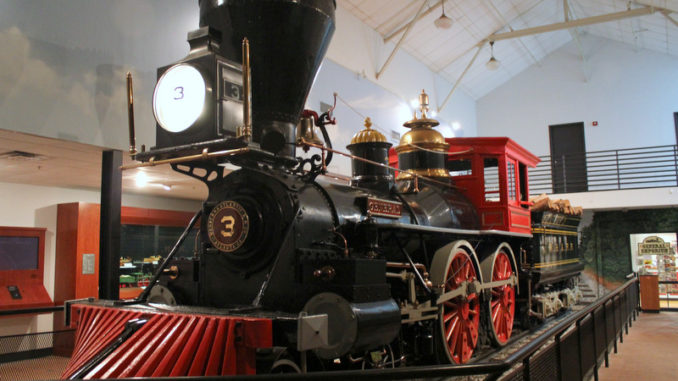
KENNESAW, Ga. – Today, the Andrews Raid is a mere bookmark in the history of the Civil War and the General sits idle – an exhibit in the Southern Museum of Civil War and Locomotive History – yards away from where she was stolen 14 decades ago.
The museum, a Smithsonian Institution Affiliate, chronicles the chase through film, reproductions and exhibits, including the famous locomotive.
But, the museum’s exhibits focus on more than the Great Locomotive Chase. Other exhibits include: the Civil War, industry in the South and archives of one of the region’s most influential railroads.
“Our focus is going to be railroads in Georgia from the 1830s to present day,” said Museum Curator George Deeming.
Glover Machine Works
Glover Machine Works was a high point in the history of the industrial South, most often noted for its agricultural economy.
The company – established in 1888 by James Bolan Glover – built at least 200 steam locomotives during a 30-year run of production. The company started out building steam driven machinery and its first steam locomotive was shipped to the Stratton Brick Company of Macon, Georgia on May 6, 1902. The last steam locomotive was shipped on April 19, 1930, but through the 1950s, the works continued to repair the engines they built.
“These went from the companies to the rail lines,” Deeming explained of how the engines were used by the companies who purchased them. “Fork lift trucks replaced them.”
Luckily for historians, the wood patterns used in designing the locomotives weren’t discarded. Instead, the works held on to these artifacts and today they are housed in the museum. Two of the works’ locomotives are also on display in a section of the museum mocked up as the company’s assembly line.
“The Smithsonian said we have one of the largest collections of railroad molds,” Deeming said of the large wood pattern collection. “It’s not as many as Baldwin or Alco used. But the difference is – the other companies usually burned theirs.”
The works’ building in Marietta, Ga., was demolished in 1995. Pictures of the structure and a model depicting the factory in its heyday are also on display. Most of the museum’s exhibits of Glover Locomotive Works were removed from the factory before it was demolished, Deeming said.
Southern Railway Archives
One of the museum’s newest acquisitions is an extensive archive collection of Southern Railway, donated by the Southern Railway Historical Association (SRHA).
Southern Railway, organized in the 1830s, was one of the largest railroads in the south. In the early 1980s, Southern Railway and Norfolk and Western formed Norfolk Southern – a large railroad still operating today.
The extensive source of documentation on the economic and social development of the southern states from 1895 until 1985 includes personal correspondence with local Chambers of Commerce, politicians and other notable public figures.
“For the past eight or nine years, we’ve spent all our time and resources accumulating these archives, not preserving them,” said George Eichelberger, Archives Director.
“This is the largest collection of archives known to exist for the Southern Railway and the Central of Georgia,” Eichelberger added. “It’s a very important historical collection that contains letters from nearly every Southern governor as well as historical figures like Booker T. Washington.”
The Great Locomotive Chase Collection
To commemorate the 100th anniversary of the Great Locomotive Chase, the Louisville and Nashville Railroad refurbished the General to working order. In 1972, the engine was given to the city of Kennesaw, and placed in the Kennesaw Civil War Museum, later renovated and renamed the Southern Museum of Civil War and Locomotive History. Today, the historical engine is the museum’s centerpiece.
In addition to the General, the museum houses assorted memorabilia related to the raid, including the Medal of Honor of John Morehead Scott, one of the raiders.
Scott, of Findlay, Ohio, was conscripted in 1861into the 21st Ohio Infantry. Some of the raiders were later awarded the country’s first Medals of Honor for their daring attempt to cut the Confederate supply lines. Seven raiders who were captured near Ringgold, Ga., were later hanged, including Scott. They were awarded the medals posthumously.
Descendants of Sgt. Scott’s widow, Rachel Scott Waggoner, loaned the Medal of Honor to the museum. To honor the family’s contribution, the museum plans to build a lifelike mannequin of Scott for display in its “Raiders Gallery,” where photos of him, his fellow raiders and the men who pursued them are also displayed.
“George Deeming found my law firm’s Web site and emailed me about the medal,” Cleveland attorney Glenn Waggoner said. “The artifact had been stored in the attic of a farm house for years. After emailing back and forth with George, and hearing about the great things the Museum was doing, my family and I thought it was a logical place for the medal.”
The story of the Great Locomotive Chase, Waggoner said, is important to his family, and his father had seen the General in both Chattanooga and Kennesaw. Waggoner himself rode the General in the early 1960s to Findlay, Ohio, home to about half a dozen of the Raiders.
At the same time, the museum is continually searching for descendants of anyone involved with the raid.
“I’m sure they’ll have some really interesting stories about the Chase that you don’t learn about in the history books, and we’d like to hear them,” Deeming said. “I found about 20 people who signed our book who mentioned they were related to Chase participants,” he said.
Deeming has heard from nearly 300 descendants of the Union participants, but only a handful of Confederate descendants.
“We’d love to hear from more of the descendants of the Chase party because their ancestors recovered the General,” he said. “Without them, we wouldn’t have the General here today.”
